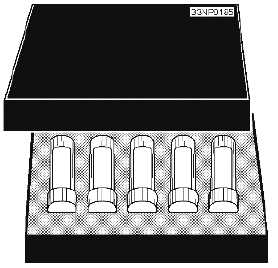2-35
designed for a multitude of applications. None of these devices are user-repairable; however, you should
be aware of the different methods of determining whether or not they are functioning properly.
FIXED RF ATTENUATORS
Fixed rf attenuators (shown in fig. 2-28), such as the ones commonly found in power-measuring sets,
are designed to provide a fixed-signal attenuation over a specific frequency range. Frequency ranges can
be in excess of 30 gigahertz, and attenuation factors are typically in 1-, 3-, 6-, and 10-dB steps. Fixed
attenuators can be connected in series to provide you with the desired attenuation. Most fixed rf
attenuators are designed to handle only small amounts of rf power and are extremely susceptible to
damage because of overloading. To test a fixed rf attenuator, you can either substitute it with a known
good attenuator or perform basic measurements on the attenuator itself. With the rf substitution method,
you connect an rf signal generator to a power meter and establish a suitable reference point on the meter
by adjusting the power output of the signal generator. Once you establish the reference point, insert the rf
attenuator between the signal generator and the power meter. You then determine the attenuation by
noting the difference between the power meter reading and the initial reference point.
Figure 2-28.—Fixed attenuator set.
Q-27.
What is the most common method of testing a fixed rf attenuator?
DECADE RESISTORS
Decade resistors (also referred to as decade boxes) typically are precision devices. Depending on the
make and model of the decade resistor, it may be capable of providing you with a selection of resistors
ranging in value from a small fraction of an ohm to hundreds of megohms. Decade resistors are
commonly used in calibration laboratories and in engineering design applications. Like the fixed rf
attenuator, most decade resistors are capable of handling only small amounts of current. They are very
limited in respect to frequency capabilities and are commonly used in dc-circuit applications. You may
encounter specific equipment that requires the use of a decade resistor in performing your maintenance
tests or alignments. To test a decade resistor, you can connect a standard multimeter or digital multimeter
directly across its resistance terminals and read its resistance on the meter. This test will only indicate
gross errors in the decade resistor such as an open or a badly damaged resistor. If you are performing a
precision measurement or an alignment using a decade resistor and have any doubt as to its accuracy, you
should submit it to your servicing calibration laboratory. Figure 2-29 shows a typical decade resistor.

